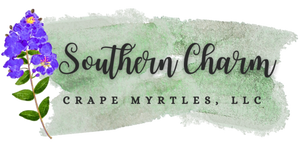Growing in Cold Climates
❄️Growing in Cold Climates❄️: How to Enjoy Stunning Crape Myrtles Up North!
Think crape myrtles are only for the South? Think again! Growing in cold climates may take a little extra effort, but with the right care, you can enjoy vibrant, colorful blooms even in cooler regions. Whether you’re dreaming of soft pinks, fiery reds, or deep purples, crape myrtles can bring a burst of summer magic to your garden—no matter where you live!
Choosing the Right Variety for Cold Climates
Not all crape myrtles are created equal! If you’re growing in cold climates, you’ll want to choose the hardiest varieties, like the Hopi, Tonto, or Sioux, which can withstand freezing temperatures better than others. Dwarf and miniature crape myrtles are also great options, as they can be grown in containers and brought indoors when winter hits.
Planting Tips for Cold-Weather Success
The secret to growing in cold climates is all about location and preparation. Choose a sunny spot, like near a south-facing wall, where your crape myrtle can soak up warmth during the day and stay protected from harsh winds. Plant in well-draining soil and add a thick layer of mulch in the fall to insulate the roots from freezing temperatures.
Winter Protection for Happy Crape Myrtles
When temperatures start to drop, your crape myrtle will need a little extra TLC. For in-ground trees, wrap them with burlap or frost blankets top to bottom, to keep them cozy through the winter. If you’re growing in cold climates with a potted crape myrtle, simply move it to a garage or enclosed porch where it can stay dormant but safe from deep freezes.
Shop Cold-Hardy Crape Myrtles Today!
Now that you know the basics to growing in cold climates, it’s time to find the perfect tree! Browse our Cold Hardy Varieties for a wide selection of crape myrtles that will thrive in cooler zones. From compact varieties perfect for pots to larger trees that can handle a frost, we have exactly what you need to add bold, colorful blooms to your northern garden.
Don’t let the cold stop you from enjoying the beauty of crape myrtles! With the right variety, a little preparation, and some winter protection, you can successfully grow these stunning flowering trees—even in chillier climates. 🌸❄️✨

Can I REALLY Grow in My Zone?
Yes, but.......
Crape myrtles are notoriously tough plants and will not only survive but thrive in various environments. Here we'll cover when to plant, what varieties will work best and proper winterization.
What is a Deciduous Hardwood?
A Deciduous Hardwood is a one that loses its leaves every winter and regrows them in spring.
Crape Myrtles, Lagerstroemia Indica and Lagerstroemia Indica x Fauriei, are NOT EVERGREENS.
They will lose their leaves each winter and regrow them in spring. Even if you're in zone 10+ you will notice a definite pause in active growth and leaf drop.
*Dormancy is not only dependent on the ambient air temperature, but hours of daylight as well. *
Deciduous hardwoods, like crape myrtles, are traditionally planted in fall. But crape myrtles will simply do better if they're planted at the right time of year, thus ensuring success.
- If you're in zones 8-10 you can plant any time of year.
- If you're in zones 6 & 7, planting after your last frost in spring (in some cases early summer), is ideal
- If you're in zone 5, you can plant in early summer after the last threat of frost. But keep in mind, if you're in zone 5 (and sometimes zone 6 depending on the severity of the winter), there is a real possibility your plants will die back to the ground over winter and regrow from the roots the following spring.
- If you're in zones 3 or 4 it's just too cold. They WILL die outside. You will have to grow them in pots and bring them into a sheltered location over winter.
Planting in Zones 8-10~Plant Any Time of Year!
- If planted while in an active state of growth (spring & summer, growing leaves/flowers), plant in full sun (6hrs+), water 2-3 times a week for the first 4-6 weeks. Then decrease watering to once a week or as needed.
- If planting while dormant, thoroughly water once initially and keep the soil light moist over winter. Natural precipitation is normally plenty in winter, but if you find yourself in a dry spell you can certainly add some moisture. Just remember, crape myrtles need good drainage.
Planting in Zones 6 & 7
- Spring planting in these growing zones is ideal. Just as soon as the soil is workable and you're not expecting a hard freeze, go ahead and plant. A light frost won't hurt them.
- If you're in zone 7, you CAN plant in fall, but you'll need to take extra precautions the first winter, including mulching heavily and covering, just to err on the side of caution. Better safe than sorry!
- There IS the possibility that your crape myrtles will die back to the ground over the first winter, especially in zone 6. Don't Panic! The roots are most certainly still alive and will send up new shoots in spring IF this happens. It's far more common than not for the top growth to survive the first winter. But we do want to make you aware that this IS a possibility, thus making your crape myrtle a perennial.
Planting in Zone 5--We won't lie, it's tough growing in zone 5.
- You MUST plant after your last frost to give them plants ample time to establish themselves before winter.
- Fall planting just doesn't have a high enough success rate to recommend. We sincerely want you to succeed. And as a knowledgeable grower you are far more likely to succeed.
- *Winterization the first year is vital! *
Planting in Zones 3 & 4--It's just not worth it
- Don't bother planting outside. They're going to die. It's simply too cold. Crape myrtles are tough, just not THAT tough!
- You CAN, however, grow them in pots. Once they drop their leaves, have gone dormant for winter and you're expecting your first hard frost, bring them into a sheltered location. An unheated garage or shed is ideal. Don't not bring them inside where it's warm: they may emerge from dormancy too early.
- Some nurseries advertise that certain varieties are suitable for growing in zones 3-5. We have found this to be unequivocal false. It is true, you can grow them in pots (see above), but growing in the ground simply doesn't work long term.
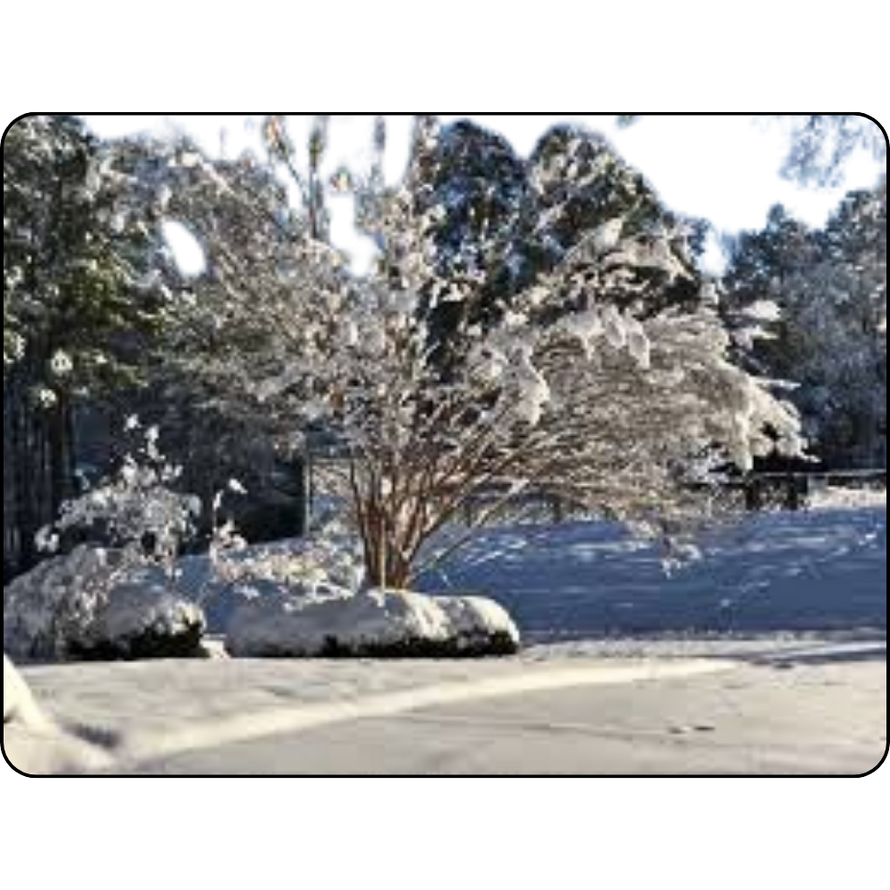
Proper Winterization
Getting your new beauties through the first winter is important, especially in colder climates. But don't let this dissuade you from grow crape myrtles! Winterization is certainly not hard and typically only needs to be done the first winter (sometimes the second year in exceptionally cold climates).
Plants in the Ground
- Discontinue all fertilization in August. Don't worry, they'll still flower.
- Once you start to notice fall colors and seed pods drying and turning brown, decrease watering to once a week or less. This gives the plant a chance to harden off before winter.
- Wait until you get your first freeze to help them shed leaves and become completely dormant.
- Once dormant and you're expecting a long, hard freeze, go ahead and mulch. Then add a healthy layer of mulch 4-6in+ thick. Any kind is fine: pine straw, fallen leaves, cypress mulch, etc.
- Now it's time to cover. The purpose is to protect the plant from the wind and snow. Before you cover, prune your tree, it will make it much easier to cover. You can use a number of things as covers. Burlap is traditional, but you can use anything from specialty plant covers, large plastic trash cans and even bubble wrap! Cover the plant from top of the branches all the way down to the mulch.
That's it! Let them sleep for the winter.
Plants in Pots or Hanging Baskets
- Discontinue all fertilization in August. Don't worry, they'll still flower.
- Once you start to notice fall colors and seed pods drying and turning brown, decrease watering to once a week or less. This gives the plant a chance to harden off before winter.
- Wait until you get your first freeze to help them shed leaves and become completely dormant.
- Once dormant and you're expecting a long, hard freeze, move them into a sheltered location like a shed of an unheated garage. Do not bring them into an area that's considerably warmer than outside (such as your living room, etc). This may encourage them to emerge from dormancy early, which can cause problems.
- Since the plants will be sheltered, you don't need to cover them or mulch them. You certainly can if you'd like, it's not going to hurt them one bit.
- Keep the soil lightly moist. This may equate to watering once a week or every couple weeks depending on the dryness of the air. The idea is that you don't want the soil to separate from the sides of the pot. If it does start to separate it will be difficult to rehydrate. In this case, place the pot in a pan of water to allow the soil to rehydrate slowly on its own.
- Prune any time. Give them a nice shape and allow them to sleep for the winter.
Removing the Covers
- Remove the plant covers and/or take the plants out of a sheltered location after the threat of a hard freeze has passed.
- Water thoroughly and keep the soil lightly moist. They'll wake up right on time.
- If your plants have already started to bud under the covers and have emerged from dormancy while they were in their winter shelter, don't panic! That's perfectly fine. It just gives them a head start on spring.
- Once you remove the covers and/or placed your plants outside in a sunny spot, you can apply dormant oil as a pest and disease control preventative.
Once your crape myrtles have 1-3in+ of new growth, begin a regular Fertilization regimen. They'll reward the extra TLC with an explosion of summer flowers.
I've Tried to Cover my Plants, but they Still Die Back to the Roots! HELP!
Sometimes Mother Nature throws us an extra cold winter. This can be hard on young crape myrtles. It's time to step up our covering game.
- Make a frame around each plant you intend to cover. You can use an old tomato cage, some chicken wire, whatever you have hand.
- Fill the cage with fallen leaves, straw or even packing material. The idea is to create a thick layer of insulation.
- You can even go one step farther and cover the whole cage with a trash bag or any number of specialty plant covers.
This is a technique northern growers use for tropical plants such as bananas, pineapples and guavas, just to name a few.
Choose Plants from Our Cold Hardy Varieties. They 're Not Only Cold Hardy, but they're also All-Around Tougher Plants!View all
-
Tonto Crape Myrtle: Vibrant Beauty and Exceptional Hardiness for Your Landscape $37.99
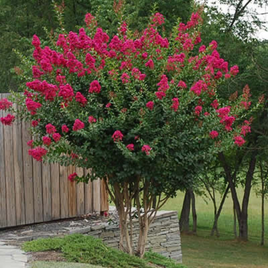
$45.99SALE -
Twilight Crape Myrtle: Sunset Purple Flowers on a Fast Growing, Elegant Tree $39.99

$49.99SALE -
Acoma Crape Myrtle: Elegant, Crisp Snow-White Weeping Beauty for Your Landscape $39.99
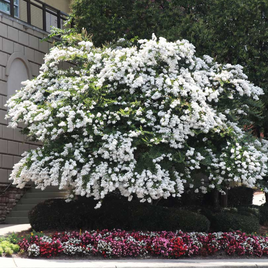
$49.99SALE -
Bashams Party Pink Crape Myrtle: Rapid Growth with Delicate Pink Blooms $39.99
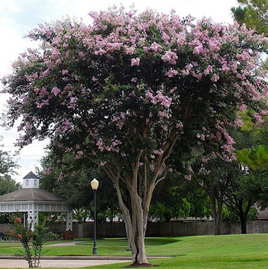
$49.99SALE -
Hopi Crape Myrtle: Vibrant, Fragrant Blooms for Your Landscape, Pollinator Favorite $39.99
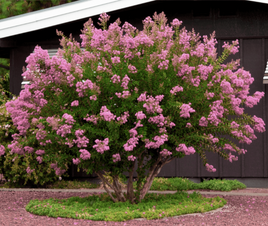
$45.99SALE -
Elizabethanne Red Passion™ Crape Myrtle: For the Lovers of True Red $45.99

$59.99SALE -
Tuscarora Crape Myrtle: Vibrant Watermelon Red Blooms and Exceptional Hardiness $39.99

$45.99SALE -
Natchez Crape Myrtle: Majestic Beauty and Continuous Blooms for Your Landscape $34.99

$49.99SALE
King's Crape Myrtle (Floribunda), and Queen's Crape Myrtle (Speciosa) ARE EVERGREENS!
*Lagerstroemia Floribunda and Lagerstroemia Speciosa can ONLY be grown in Zones 9-10+. They are Tropical plants thus they stay green all year. They WILL DIE BACK TO THE GROUND if exposed to a Freeze.*
❄️We are Not Responsible for Cold Damage⛄
Ultimately, we cannot control the weather. As such, we will not take responsibility for cold damage, fires, floods, droughts, plagues, blights or any other acts of God.
It's up to YOU, as the grower, to protect and care for your new crape myrtles accordingly. But don't worry, we'll help every step of the way!
